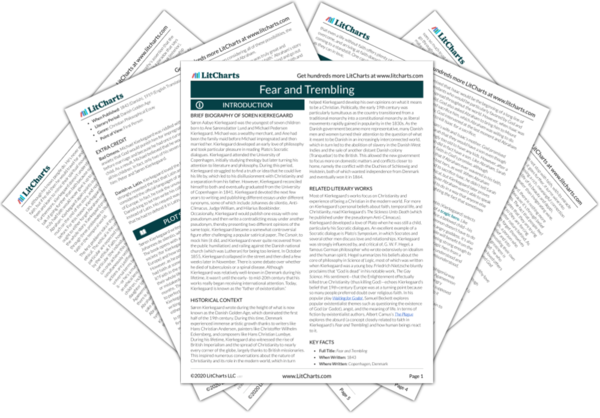Welcome to the LitCharts study guide on Søren Kierkegaard's Fear and Trembling. Created by the original team behind SparkNotes, LitCharts are the world's best literature guides.
Fear and Trembling: Introduction
Fear and Trembling: Plot Summary
Fear and Trembling: Detailed Summary & Analysis
Fear and Trembling: Themes
Fear and Trembling: Quotes
Fear and Trembling: Characters
Fear and Trembling: Symbols
Fear and Trembling: Theme Wheel
Brief Biography of Søren Kierkegaard

Historical Context of Fear and Trembling
Other Books Related to Fear and Trembling
- Full Title: Fear and Trembling
- When Written: 1843
- Where Written: Copenhagen, Denmark
- When Published: 1843 (Danish), 1919 (English Translation)
- Literary Period: Danish Golden Age
- Genre: Christian Philosophical Essay
- Point of View: First Person
Extra Credit for Fear and Trembling
Bad Omens. Michael Kierkegaard was riddled with fear and anxiety that God would punish him for impregnating his wife before marriage and because he had once cursed God as a child. As a result, Michael believed that he would have to bury all his children. In fact, only two of his seven children survived him: Peter and Søren Kierkegaard.
Danish vs. Latin. Kierkegaard loved the Danish language and strongly resented the fact that Latin and German were considered the official languages of academia throughout most of Europe. In fact, he took the unusual step of petitioning the Danish king to let him write his college dissertation in Danish instead of Latin. His request was granted, but with the caveat that he had to defend it in Latin.







